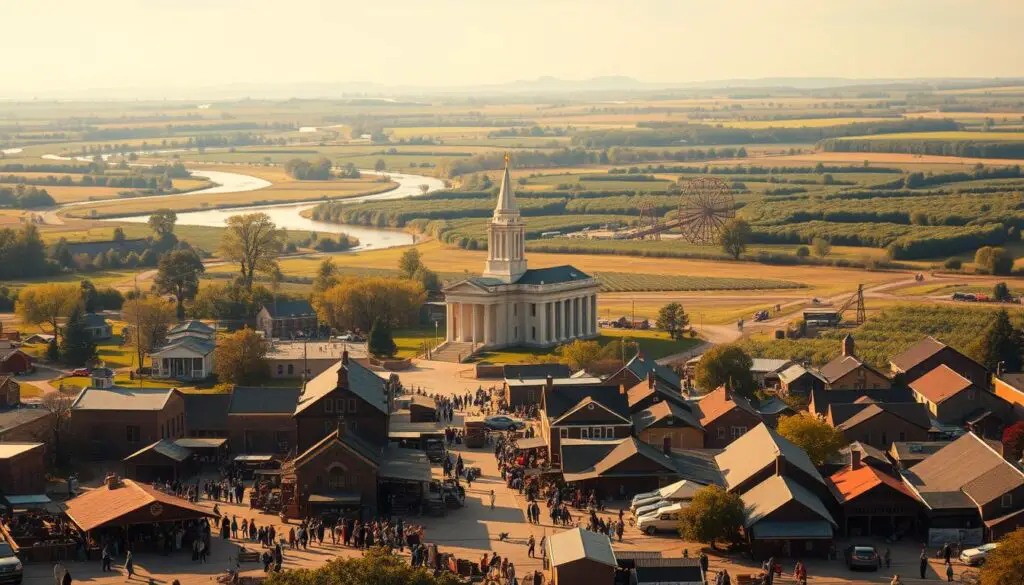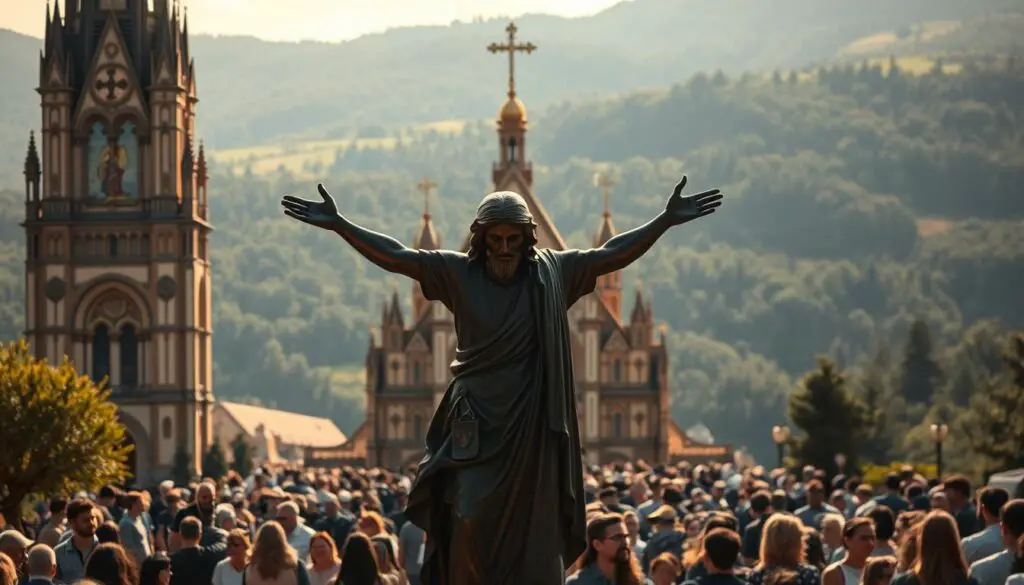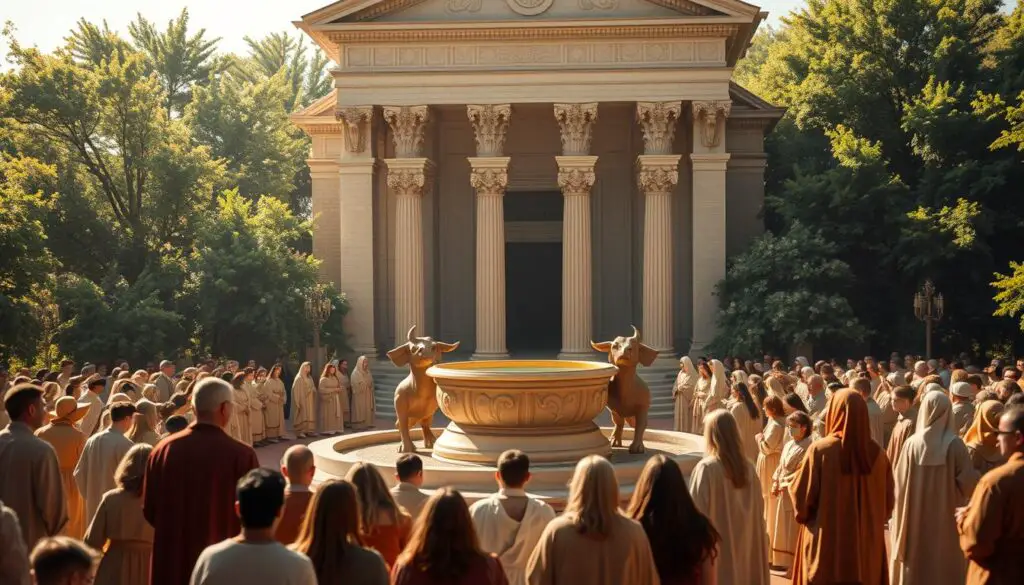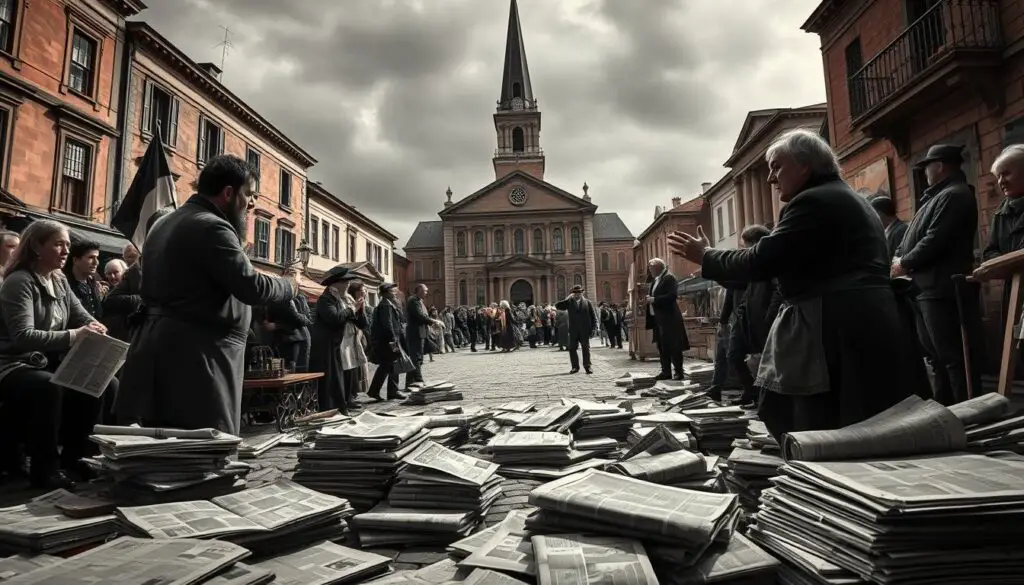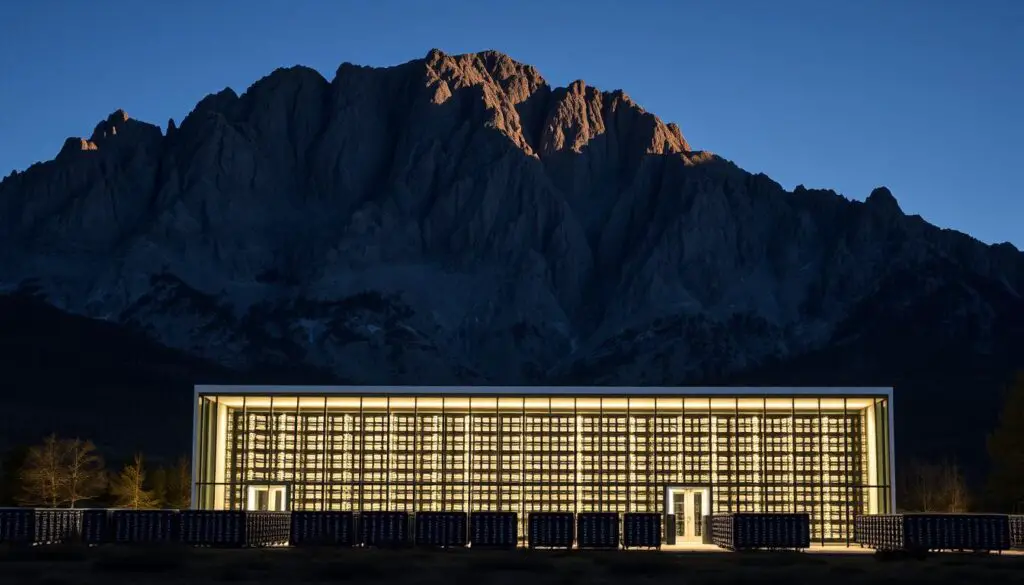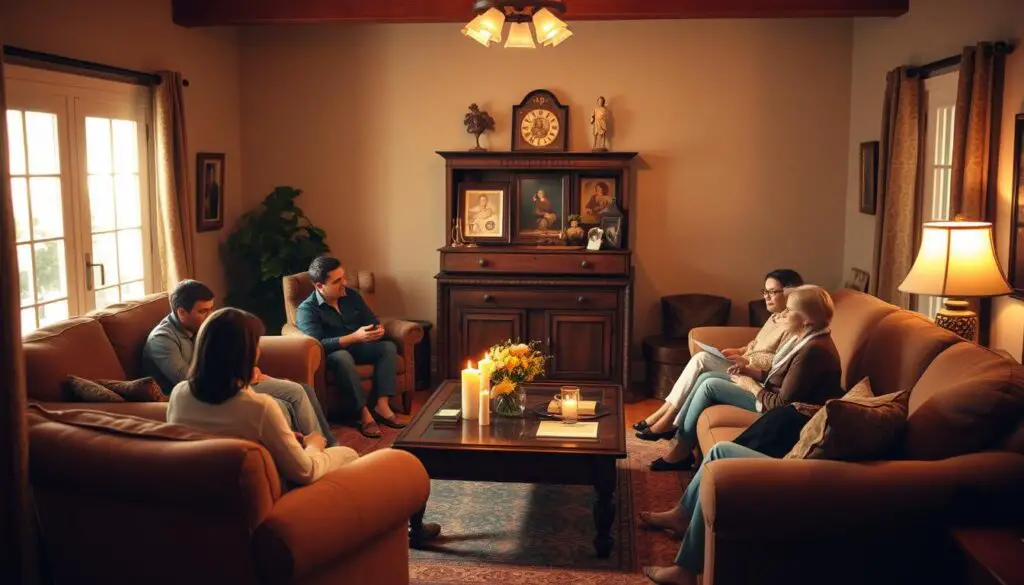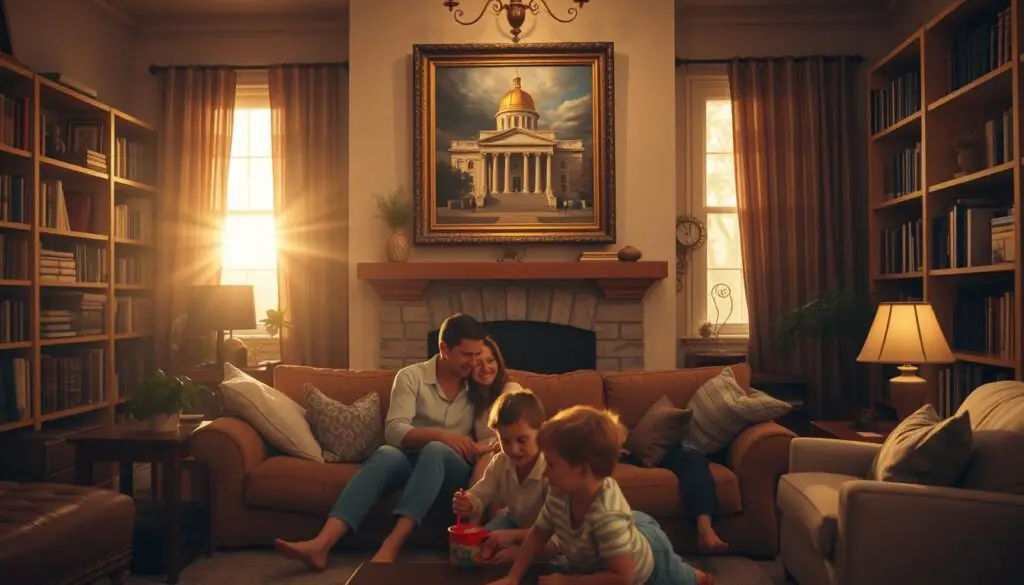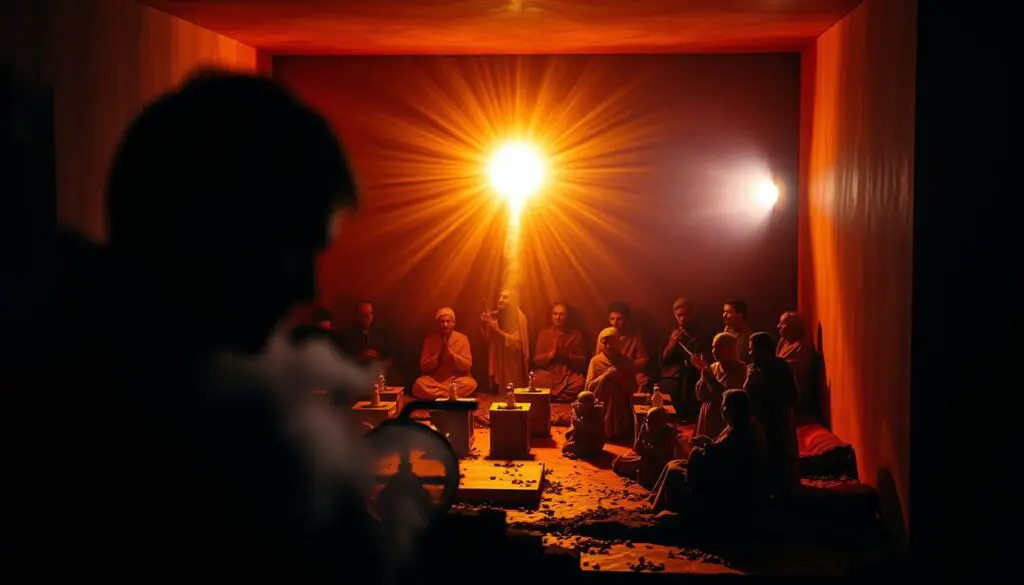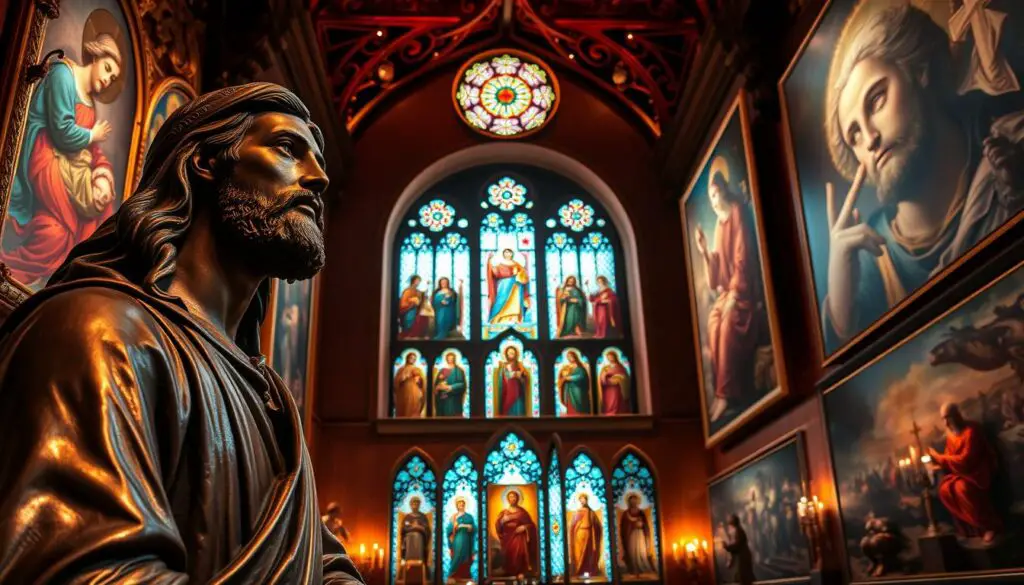In the mid-1800s, tensions between settlers and the U.S. government shaped the American West. One pivotal group emerged during this era—a religiously organized armed force that played a critical role in defending their community. Their actions laid the foundation for how the region navigated political and cultural challenges.
At the heart of this story was a prominent leader whose vision guided the settlement of the territory. Brigham Young, known for his decisive leadership, mobilized local resources to protect his followers. The strategic location of Salt Lake became central to these efforts, serving as both a sanctuary and a stronghold.
Conflicts arose as federal authorities sought to assert control over the area. These clashes highlighted the struggle between self-governance and national oversight. Over time, the events surrounding this period would come to define the region’s identity and its relationship with the rest of the country.
Key Takeaways
- The religiously-aligned armed group was vital in defending settlers during territorial disputes.
- Brigham Young’s leadership shaped the community’s response to external pressures.
- Salt Lake’s geographic position made it a hub for cultural and military planning.
- The Utah War underscored tensions between local autonomy and federal authority.
- This era set the stage for the territory’s eventual integration into the United States.
Introduction to Utah’s Mormon Militia
The establishment of a citizen-led defense group marked a turning point in regional history. Settlers in the Great Basin faced threats from conflicts over land and resources. To counter these challenges, they organized a volunteer force focused on community protection.
Local men formed the backbone of this group. They trained regularly, blending frontier survival skills with military drills. Families relied on their efforts for safety, as federal troops were often distant or slow to respond.
Tensions with the national government accelerated the need for self-reliance. When disputes arose over territorial control, the group adapted its strategies. This included building outposts and stockpiling supplies for emergencies.
Religious leaders directed the force, merging spiritual guidance with tactical decisions. Their dual role created a unique dynamic between faith-based governance and federal expectations. This friction would later shape pivotal moments in the region’s development.
The Historic Migration and Settlement of Utah
The Great Basin’s arid landscape became the backdrop for a remarkable settlement story. In 1847, over 2,000 pioneers trekked 1,300 miles across plains and mountains to reach their new home. Facing brutal winters and scarce water, they relied on cooperation to survive. Their journey symbolized both faith and determination.
Brigham Young, appointed as the first governor of the territory, organized settlements with precision. He directed irrigation projects to transform dry valleys into farmland. Communities pooled resources, building schools and roads. “We must make the desert blossom,” he urged, inspiring collective effort.
Federal leadership initially clashed with local governance. When tensions over land rights escalated, preparedness became vital. Stockpiling food and weapons wasn’t just practical—it was a statement of self-reliance. These actions laid groundwork for later disputes some called a war of wills.
By 1850, the territory had grown into a thriving network of towns. The governor’s policies fostered unity, but external pressures tested their resolve. Challenges of migration forged a culture ready to defend its vision of independence.
Religious Foundations and Political Ideologies
Religious principles and political strategies merged uniquely in shaping early territorial governance. This fusion created a blueprint for survival in a harsh landscape while defending cultural autonomy.
Brigham Young’s Vision and Leadership
As both spiritual guide and territorial leader, Brigham Young blended faith with practicality. He established councils that handled everything from land distribution to dispute resolution. “Unity is our strength,” he declared, urging settlers to prioritize communal needs over individualism.
Distances of hundreds of miles between outposts challenged communication. Young responded by creating relay stations for messengers. This network allowed rapid coordination across valleys and mountains.
Plural Marriage and Church Governance
Polygamy became a cornerstone of social structure, reinforcing family ties and resource sharing. Church leaders held dual roles—overseeing spiritual matters while managing civic infrastructure like roads and irrigation.
Salt Lake City emerged as the heart of this system. Its central location in the Salt Lake Valley made it a hub for trade and decision-making. Nearby towns mirrored its layout, emphasizing orderly growth.
These foundations influenced defense strategies. Local units organized drills near Salt Lake City, preparing to protect their way of life. Young’s dual authority ensured religious and political goals stayed aligned, even during crises.
Build-Up and Tensions Leading to the Utah War
By 1857, simmering disagreements erupted into a crisis. Federal authorities grew uneasy with the Utah Territory’s self-governance. President Buchanan sent troops to replace local leaders, viewing their independence as defiance. This move sparked fear among settlers, who saw it as an invasion.
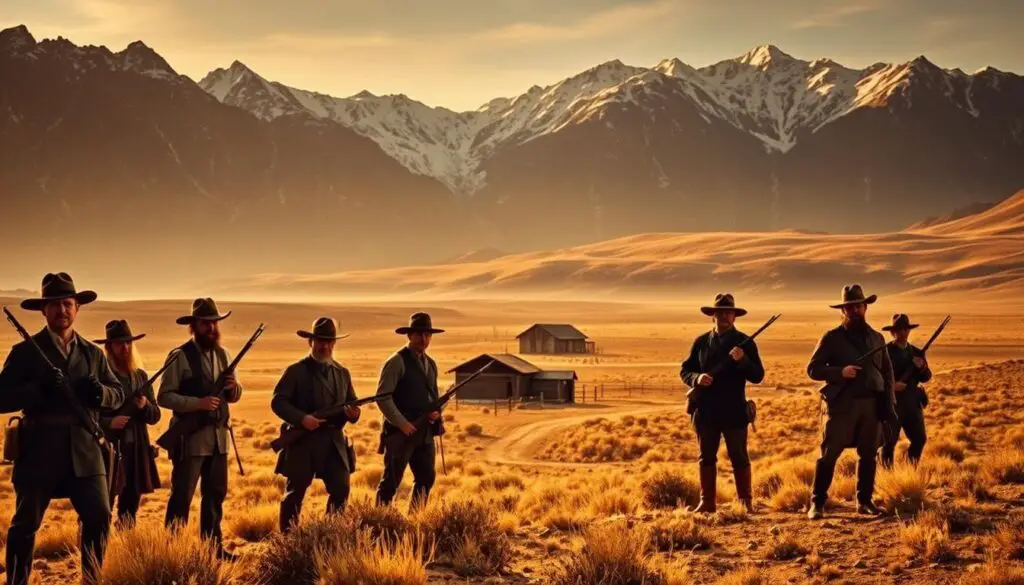
In Lake City, residents stockpiled grain and weapons. They burned supply wagons to slow approaching soldiers. “We’ll protect our homes at any cost,” one settler wrote. These acts of resistance turned isolated friction into widespread alarm.
The territory’s remote location fueled its defiant spirit. With limited federal oversight, communities developed their own laws and defense plans. When outsiders questioned their practices, distrust grew deeper.
Most clashes stayed small at first. Volunteers harassed troops with hit-and-run tactics. They blocked mountain passes and poisoned livestock. Though no major battles occurred, both sides braced for escalation.
This localized friction laid the groundwork for the Utah War. What began as cultural misunderstandings spiraled into a standoff. The territory’s fierce independence collided with national ambitions, setting the stage for conflict.
Outbreak of the Utah War: Causes and Early Conflicts
A tragic event in September 1857 would ignite national outrage and reshape the trajectory of territorial disputes. Two critical factors collided: a shocking act of violence and federal attempts to assert control. These forces transformed simmering disagreements into open confrontation.
The Mountain Meadows Massacre and Its Implications
In southern Utah, a wagon train from Arkansas met disaster. Local settlers and Paiute allies attacked the group, killing over 120 emigrants. News of the massacre stunned the nation, fueling perceptions of lawlessness in the West. “This horror must never repeat,” declared eastern newspapers, deepening distrust.
While motives remain debated, the tragedy amplified fears of civil war. Many saw it as evidence of unchecked frontier violence. Federal leaders used the incident to justify stronger intervention in territorial affairs.
Federal Orders and Rising Tensions
President James Buchanan responded decisively. He ordered 2,500 troops to replace local officials and install a new governor. “The territory must submit to federal authority,” he insisted, viewing self-rule as rebellion.
Settlers interpreted these moves as aggression. They burned supply trains and prepared defenses, convinced the government sought to destroy their way of life. President Buchanan’s actions unintentionally united communities against a common threat.
As both sides dug in, whispers of civil war spread. Though full-scale conflict never erupted, the standoff revealed how quickly misunderstandings could escalate. This clash of wills set patterns for future territorial integration challenges.
mormon militia utah: The Militia’s Formation and Structure
When federal pressures mounted in the 1850s, settlers reorganized their community defenses into a formalized system. This effort revived the Nauvoo Legion—a volunteer force originally created in Illinois. Brigham Young oversaw its re-establishment, blending frontier resilience with disciplined ranks.
The Origins of the Nauvoo Legion
Named after its Illinois predecessor, the Legion became the backbone of local security. Members trained weekly, mastering horsemanship and marksmanship. “We stand united,” declared one captain, reflecting their communal ethos.
Leadership shifted when a new governor arrived in 1858. Alfred Cumming’s appointment tested the Legion’s loyalty. Yet, most volunteers prioritized protecting settlements over political changes. Strategic outposts like Fort Bridger served as supply hubs, guarding vital trails into the lake valley.
The force mirrored U.S. Army structures, with companies divided into infantry and cavalry. Officers reported to regional commanders, ensuring swift coordination. This hierarchy proved crucial during supply raids and border skirmishes.
Today, the Legion’s legacy lives in community preparedness programs. Their blend of adaptability and unity offers lessons for modern crisis response—a testament to frontier ingenuity.
Defensive Strategies and Tactics Employed by the Militia
Facing imminent federal intervention, local forces devised creative methods to protect their settlements. One tactic involved setting fire to supply wagons and grasslands along invasion routes. This scorched-earth approach left advancing troops without food or fodder, slowing their progress through the rugged terrain.
Guerrilla-style ambushes became another key strategy. Small groups hid in narrow mountain passes, attacking federal convoys before vanishing into the wilderness. “We strike fast and disappear like shadows,” recalled a captain in 1858. These hit-and-run tactics frustrated larger, better-equipped armies.
Religious leaders coordinated defenses through coded messages and relay riders. They organized drills to train troops in marksmanship and horseback combat. Recruits learned to dismantle bridges and block roads with fallen trees—delaying maneuvers that bought time for communities to evacuate.
Local officials like Lot Smith led daring raids, burning three federal supply trains near Fort Bridger. Such bold actions showcased their adaptability. Though outnumbered, their knowledge of the land turned deserts and canyons into natural fortresses.
Training evolved as tensions grew. Volunteers practiced nighttime maneuvers and signal systems to outwit opponents. This blend of frontier ingenuity and disciplined preparation kept settlements one step ahead during the crisis.
The Role of Salt Lake City and Local Communities
Salt Lake City’s central location made it the beating heart of regional defense efforts during critical years. As tensions peaked, the city became a supply depot and communication nexus. Over 1,200 soldiers were stationed here at key times, guarding vital routes into the valley. Local blacksmiths worked day and night to produce weapons, while families donated food stores to sustain troops.
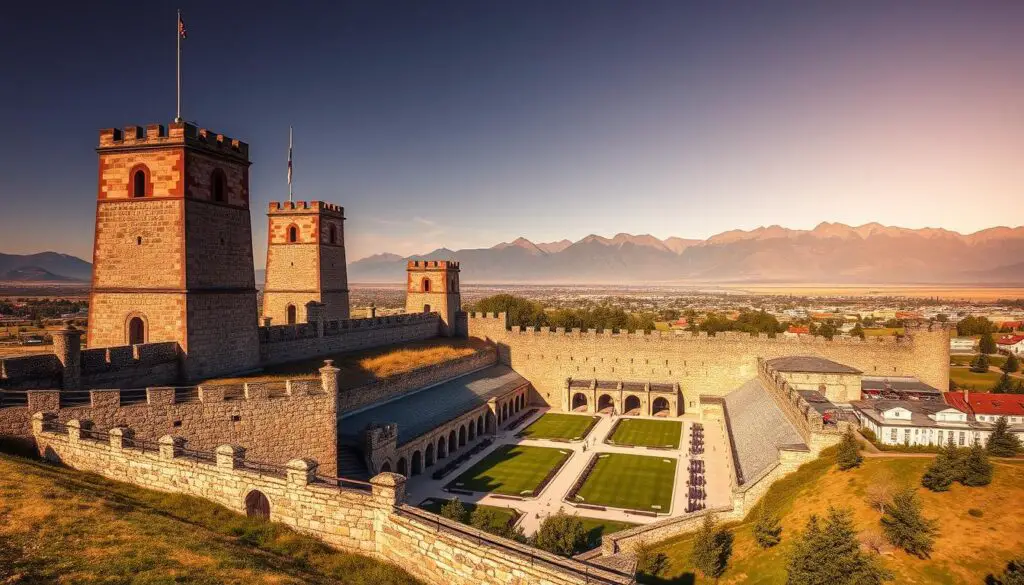
Years of conflict reshaped nearby towns. In 1858 alone, records show 85% of able-bodied men from surrounding areas joined patrols. Women managed farms and workshops, keeping daily life stable. “Every hand had work,” wrote one diarist, describing how even children carried messages between outposts.
The city’s strategic timing saved lives during crises. When federal troops approached in winter, locals burned their own crops to deny invaders supplies. This sacrifice bought time for families to evacuate to mountain hideouts. Five years later, similar tactics protected settlements during renewed tensions.
Community support proved decisive. Farmers lent horses for cavalry units, and churches became makeshift hospitals. Without this unity, the volunteer soldiers couldn’t have held their ground. Their shared resolve turned Salt Lake City into both a shield and a symbol of resilience.
Navigating Federal Authority and Territorial Governance
The shift in territorial leadership during the late 1850s tested the delicate balance between community autonomy and national oversight. As federal officials sought tighter control, local leaders faced a critical choice: resist or adapt.
Transition of Power: From Brigham Young to Alfred Cumming
When President Buchanan appointed Alfred Cumming as governor in 1858, tensions erupted. Many settlers viewed the move as federal overreach, fearing their way of life was under threat. “We built this land through sacrifice,” argued one community elder, reflecting widespread distrust of outside authority.
Cumming’s arrival sparked immediate friction. Local leaders initially refused to recognize his authority, creating a governance stalemate. Tax collection halted, and land disputes multiplied as competing systems clashed. Federal troops stationed nearby heightened anxieties, with some families stockpiling weapons.
Structured leadership proved vital during this upheaval. While Young stepped back from formal power, his influence remained strong. He urged cooperation to avoid violence, stating, “Wisdom lies in measured responses.” Meanwhile, Cumming worked to establish dialogue, touring settlements to build trust.
Key conflicts emerged over:
- Control of public funds and infrastructure projects
- Enforcement of federal vs. local laws
- Management of communication routes like the Overland Trail
Influential figures on both sides sought middle ground. Cumming eventually gained partial acceptance by allowing local customs to coexist with federal mandates. This uneasy compromise showcased how leaders could navigate polarized environments through pragmatic flexibility.
How the Utah War Influenced Local and National Politics
The Utah War’s resolution sparked a reevaluation of governance structures on both regional and national levels. People across the territory debated how much autonomy communities should retain versus federal oversight. These discussions rippled into Congress, where lawmakers grappled with balancing frontier independence with national unity.
Controversies over law enforcement dominated post-war reforms. Incidents like the Mountain Meadows Massacre raised questions about local justice systems. “Can remote territories uphold the rule of law without federal support?” asked Eastern newspapers, fueling heated debates.
Three key areas of control shifted after the conflict:
| Aspect | Local Governance | Federal Response |
|---|---|---|
| Leadership Appointments | Community-elected officials | Required presidential approval |
| Law Enforcement | Volunteer peacekeepers | Increased U.S. Marshal presence |
| Communication | Relay rider networks | Federal telegraph subsidies |
These changes empowered people to demand clearer legal frameworks. By 1861, the territory established its first civilian courts, blending local customs with federal statutes. Religious leaders gradually shared authority with appointed judges, easing tensions.
Modern parallels persist in debates about states’ rights versus federal mandates. The war’s legacy reminds us that sustainable control requires balancing community needs with national law. As one historian notes, “Those 19th-century struggles taught us how to negotiate unity without uniformity.”
The Involvement of the Militia During the Civil War Period
With the country at war, local defense groups adapted to protect vital routes. The Nauvoo Legion—a volunteer force originally formed in Illinois—was reactivated in 1861. Their mission: guard critical supply lines like the Overland Trail from potential raids. Over 800 soldiers mustered within weeks, showcasing their rapid response capabilities.
Utah’s Territorial Defense in Action
The force remained vigilant through a series of strategic moves. They established checkpoints along mountain passes and increased daylight patrols. “Readiness is our shield,” declared one officer, emphasizing daily drills that sharpened marksmanship and horsemanship.
Key actions included:
- Building a series of outposts along the Central Overland Route
- Conducting mock battles twice weekly to simulate attacks
- Coordinating with nearby settlements through coded smoke signals
| Activity | Utah War (1857-1858) | Civil War (1861-1865) |
|---|---|---|
| Supply Route Defense | Burned wagon trains | Guarded telegraph lines |
| Communication Networks | Relay riders | Semaphore flag systems |
| Training Frequency | Weekly drills | Day-to-day exercises |
This preparedness proved crucial when tensions flared in 1862. Though no major battles occurred, the series of conflicts tested their resolve. The force’s legacy lived on through community-led safety programs, blending frontier ingenuity with disciplined cooperation.
Organizational Structure and Military Protocols
Military precision and community cooperation defined the defense group’s daily operations. Elected captains managed each company, chosen for their experience and community trust. These leaders balanced input from local councils with battlefield authority, creating a unique blend of democracy and hierarchy.
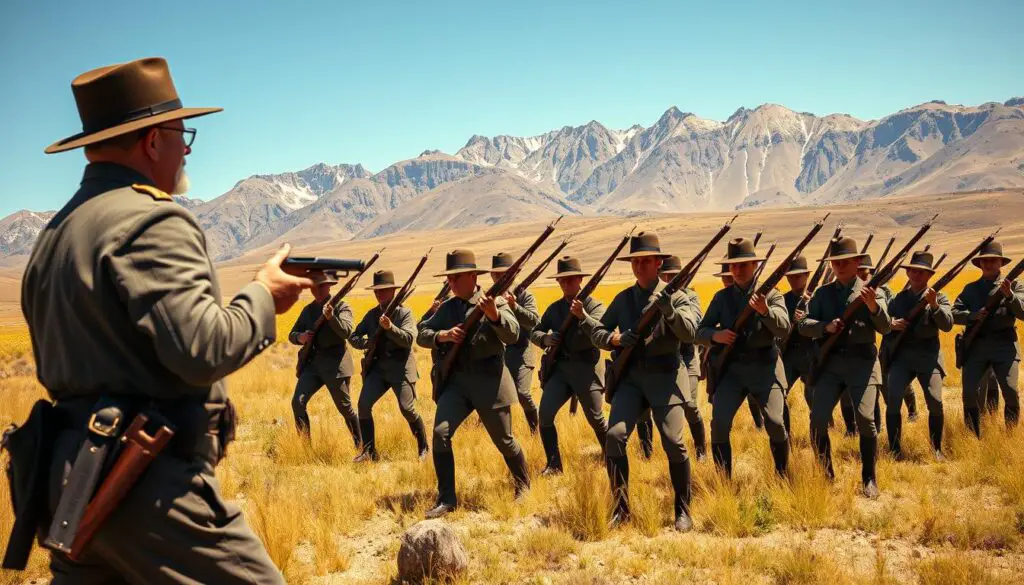
Drill, Uniforms, and Militant Discipline
Weekly drills resembled clockwork. Volunteers practiced:
- Formation shifts in under two minutes
- Reloading muskets while kneeling
- Coordinated cavalry charges across open fields
Uniform standards enforced unity. Soldiers wore:
- Gray wool coats with brass buttons
- Black felt hats bearing unit insignias
- Handmade leather boots for rugged terrain
Discipline extended beyond combat. A private journal notes: “We maintained peace through order—late arrivals faced extra sentry duty.” This structure contrasted sharply with chaotic violence during skirmishes. Officers resolved disputes through mediation first, reserving punishments for repeated offenses.
Training manuals emphasized preparedness over aggression. Leaders drilled de-escalation tactics alongside marksmanship, believing true strength lay in preventing violence. This philosophy created a rare peace within ranks, even as external tensions simmered.
Impact on Cultural Identity and the Path to Statehood
Resilience forged through hardship became the bedrock of regional identity. Stories of cattle drives across arid plains symbolized self-reliance, with herds often outnumbering settlers ten-to-one. “Every steer carried our future,” wrote one pioneer, capturing how livestock management shaped communal values.
The Great Salt Lake emerged as both a geographical anchor and spiritual metaphor. Its shimmering waters reflected the perseverance taught by Jesus Christ Latter-day teachings, blending faith with frontier survival. Annual gatherings near its shores celebrated shared triumphs over drought and conflict.
Cultural pride grew through creative adaptations. Families repurposed wagon parts into farm tools, while children memorized hymns about overcoming adversity. These practices, rooted in Jesus Christ Latter-day principles, reinforced unity during uncertain times.
When seeking statehood, leaders highlighted this legacy of determination. They pointed to thriving cattle ranches and irrigation systems around the Great Salt Lake as proof of stable governance. Today, rodeos and harvest festivals honor those early struggles—a testament to how hardship sculpted an enduring identity.
Personal Stories and Community Experiences from the Conflict
Diaries from frontier families reveal the human cost of political strife. Mary Ann Weston, a mother of six, wrote in 1857: “We buried our silverware beneath the cornfield when soldiers came. Every night, we prayed they’d pass us by.” Her account mirrors countless others who faced uncertainty with quiet courage.
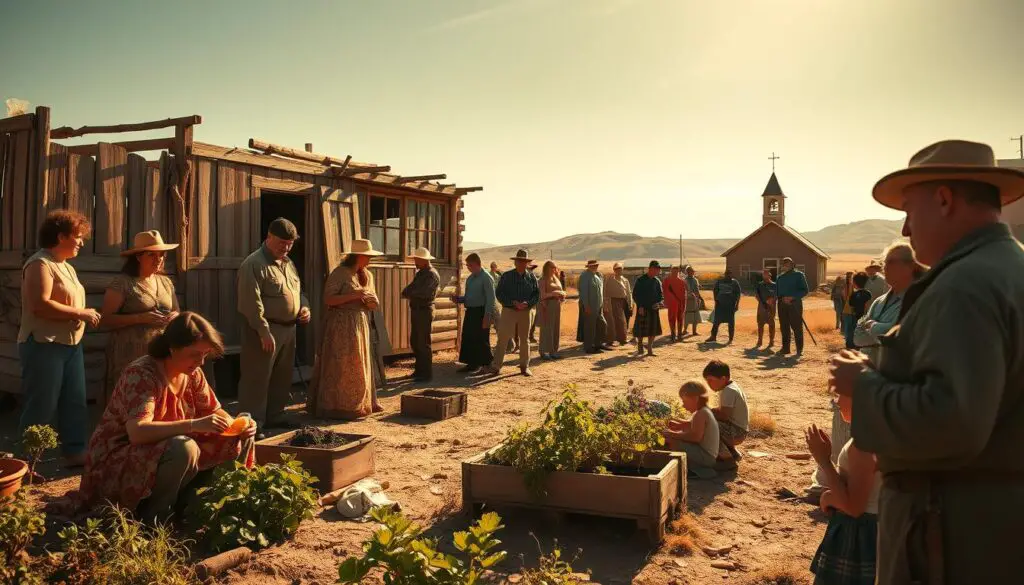
The Church of Jesus Christ became a lifeline during crises. Local leaders organized rotating shifts to guard crops and share meals. “We were not just neighbors—we were stewards,” recalled James Covington, who lost his barn defending a neighbor’s grain store. This unity defined the Christ latter-day saints’ response to hardship.
President James Buchanan’s decision to send troops reshaped daily life. Families abandoned homesteads near military routes, clustering in fortified towns. Women like Eliza Partridge spun wool into uniforms while teaching children scripture. “Faith anchored us,” she noted, describing how the Church of Jesus Christ provided structure amid chaos.
Community sacrifices included:
- Burning their own crops to starve approaching forces
- Housing displaced families in overcrowded meetinghouses
- Donating heirlooms to fund emergency supplies
These acts forged bonds that outlasted the conflict. As one elder summarized: “Our trials didn’t break us—they showed us who we could become.” The Christ latter-day saints’ blend of grit and compassion remains a testament to human resilience.
Broader Historical Significance and Lessons Learned
The Utah War’s echoes reached far beyond mountain valleys, shaping national debates about freedom and governance. It challenged the United States to rethink its approach to religious minorities, setting precedents for balancing federal authority with cultural autonomy. “No community should face isolation for its beliefs,” argued reformers, citing the conflict’s aftermath.
For the Latter-day Saints, the struggle became a masterclass in adaptation. Their ability to build self-sufficient communities in harsh environments inspired later frontier settlements. New York’s early role as their birthplace lingered in collective memory—a reminder of how persecution fueled westward migration.
Three key policy shifts emerged post-conflict:
| Area | Pre-War Approach | Post-War Reform |
|---|---|---|
| Religious Rights | Limited protections | Expanded legal safeguards |
| Territorial Oversight | Direct federal control | Gradual autonomy grants |
| Conflict Resolution | Military intervention | Negotiated settlements |
These changes influenced how the United States managed cultural diversity during westward expansion. The Latter-day Saints’ emphasis on communal planning offered blueprints for disaster response in arid regions. Meanwhile, New York’s legacy as a starting point underscored the link between urban origins and frontier resilience.
Modern parallels exist in debates over state power versus minority rights. The Utah War reminds us that lasting unity requires respecting differences while upholding shared values—a lesson etched into America’s evolving story.
Conclusion
The story of frontier defense in the 19th century reveals how communities navigated crises through unity and ingenuity. Religious beliefs shaped strategies for protecting settlements, blending spiritual purpose with practical preparedness. This approach left a lasting mark on regional identity and governance models.
Historical accounts of the Utah expedition underscore the complexities of self-rule during territorial expansion. Lessons from this era remain relevant, illustrating how cultural values influence conflict resolution and civic cooperation. Modern leaders can draw parallels when balancing local traditions with broader policies.
Exploring these events invites deeper reflection on resilience. Museums and archives across the region preserve artifacts and diaries that bring this pivotal period to life. Their collections offer tangible connections to the past—reminders of how determination forged a unique path forward.
By studying these chapters, we gain insights into the interplay of faith, community, and survival. Such stories challenge us to consider how history’s echoes shape today’s debates about autonomy and collective responsibility.
FAQ
What was the Nauvoo Legion’s role in early Utah settlements?
The Nauvoo Legion, originally formed in Illinois, became a key defensive force for Latter-day Saint pioneers in the Salt Lake Valley. It protected communities, managed resources, and enforced order under Brigham Young’s leadership during westward expansion.
How did federal policies escalate tensions before the Utah War?
President James Buchanan’s decision to replace Brigham Young as governor and send troops to enforce federal authority sparked distrust. Miscommunication and rumors of aggression led both sides to prepare for conflict, heightening regional instability.
Why was Salt Lake City central to the militia’s strategies?
As the territorial capital and religious hub, Salt Lake City housed critical supplies and leadership. Defensive plans included evacuating residents and burning the city if federal troops advanced, showcasing its symbolic and tactical importance.
How did the Utah War influence the territory’s path to statehood?
The conflict delayed statehood by deepening federal suspicion of Latter-day Saint governance. However, compromises like ending plural marriage and aligning with U.S. laws eventually eased tensions, paving the way for Utah’s admission in 1896.
What role did the territorial militia play during the Civil War?
Though largely uninvolved in major battles, the militia guarded communication routes and settlements. Their presence ensured stability in the West while federal forces focused on eastern conflicts.
How did Brigham Young’s leadership shape the militia’s actions?
Young blended religious authority with military strategy, positioning the militia as both a spiritual and physical protector. His directives emphasized unity, self-reliance, and resistance to perceived federal overreach.
What cultural impacts did the Utah War leave on local communities?
The conflict reinforced a collective identity centered on resilience and religious solidarity. Stories of survival and defiance became part of regional heritage, influencing traditions and attitudes toward external governance.
